Electrical MCQs
1) Which of the given motor has insufficient starting torque at full load speed with the same H.P. ratings?
- Three-phase Induction motor
- Shunt motor
- Synchronous motor
- Differential compound motor
Answer: Option d.
Explanation: Differential compound motor has poor starting torque at full load speed with same H.P. ratings because its shunt fields restrict series field. The primary reason for the less starting torque than the motor is reduced field flux. The Dc compound motor is a type of self-excited motor, but it is a compound of both series and shunt field coils connected to the armature winding. A series field winding connected in series with the armature and a shunt field winding connected in parallel to the armature.
2) Which of the given networks are based on the compensation theorem?
- Unilateral network
- Bilateral network
- Linear and non-linear network
- Distributed network
Answer: Option c.
Explanation: Linear and non-linear network is based on compensation theorem. A linear network refers to networks whose parameters(Resistance, capacitance, Inductance, etc.) are not changed with respect to current and voltage. In contrast, the non-linear network parameter changes with respect to current and voltage.
3) The ratio of the Mechanical Impedance is
- RMS force to RMS displacement
- RMS velocity to RMS acceleration
- RMS force to RMS velocity
- RMS current to RMS speed
Answer: c
Explanation: We know that a force is analogous to voltage to the current, which is given as

Force/Velocity = Mechanical impedance. Impedance is similar to resistance in D.C. In A.C. and an additional opposing force acts in addition to resistance. The total opposing force is known as Impedance.
4) In a two-wattmeter method, the measured power was 40kW At 0.8 lagging power factor. Calculate the reading of each wattmeter
- W1 = 34.875 and W2 = 5.125
- W1= 33.875 and W2 = 6.125
- W1 = 38.875 and W2 = 6.125
- W1 = 32.875 and W2 = 5.125
Answer: b
Explanation:
Given;
Power(P) = 40 Kw and cos?φ = 0.7 lagging
Let’s suppose W1 and W2 are the readings of two wattmeters method
Then, P = W1 + W2 = 40 kW
Now, cos?φ = 0.8 lagging, = tan?(cos-1?0.7) = 1.0202
We know the formula of two wattmeter method to calculate the power measurement
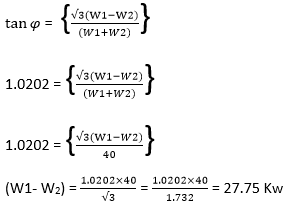
Therefore,
W1– W2 = 27.75 Kw
And we know that W1+ W2 = 40 Kw
Adding the above equation we get,
W1– W2+ W1+ W2=67.75
2 W1 = 67.75
W1 = 33.875
And, we know that
W1+ W2 = 40 Kw
Putting the value of W1 = 33.875 in the above equation
33.875+ W2= 40 Kw
W2 = 40-33.875 = 6.125
5) Under no-load conditions, the transmission line carrying a current because of
- Heating effect
- Capacitance effect
- Chemical effect
- Transmission effect
Answer: b
Explanation: Under no-load conditions, the transmission line carrying a current because of the capacitance effect. Under the no-load condition, the current in the line is due to the flow of charge only (Increase Ferranti effect), and the charging current is due to the formation of capacitance between the transmission line and earth.
6) In a synchronous machine, the V curve is drawn between which of the given axis.
- Field current on X-axis and no-load current on Y-axis
- Armature current on X-axis and the no-load current in Y-axis
- Field current on X-axis and armature current on Y-axis
- Armature current on X-axis and filed current on Y-axis
Answer: c
Explanation: In the synchronous machine, V curves refer to a graph depicting the relationship between Field current on the X-axis and Armature current on the Y-axis.
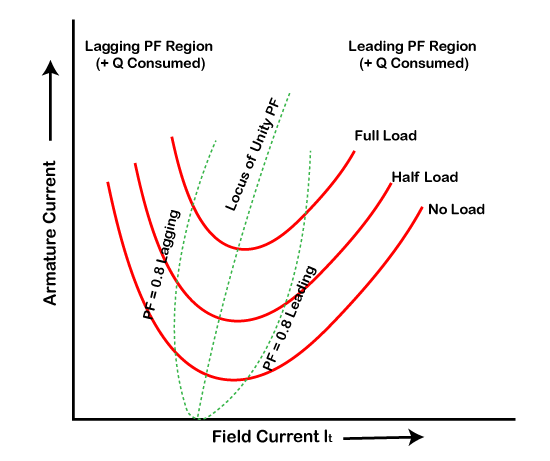
The graph located above represents the V curve of a synchronous motor. The middle line represents the unity power factor line and the right-hand side of the unity power factor line considered as lagging power factor line.
It reduces the external D.C. voltage source using the controlled rectifier, which causes more lagging current to make constant air gaps, and during this process, the field current is kept lower.
7) The spot welding is used for
- Joint thick sheets
- Rough surface
- Thin metal sheets(10-12mm)
- T shape welding
Answer: c
Explanation: Spot welding refers to a process of joining two pieces of thin sheet metal and fusing them with the help of copper electrodes, and a high current is passed that heat the two metal pieces causes them to fuse at that point. The electrodes are made up of copper and are water-cooled.
8) In a 3-Ø induction motor, the starting current is 8 times the rated current, and the rated slip is 6 %, then find the ratio of starting torque to full load torque.
- 1
- 1.5
- 1.75
- 2
Answer: b
Explanation:
Given;
Ist/Ifl = 5
= Sfl/Sst = 6%
= reα I22/s = Tst/Tfl
= (Ist/Ifl)2 × Sfl/Sst
= (5)2×(0.06)
= 25×0.06=1.5
9) The single-phase reluctance machine works as a generator when the value of ? is
- Infinitive
- Zero
- Unity
- Positive
Answer: d
Explanation: We know the formula of Average to toque = Øm2(Rid – RIq) sin(2)
Øm2(Rid – RIq) sin(2)
When the value of is negative, the developed toque will be reversed, so the machine will act as a generator.
10) In a series circuit, the value of resistance is 40 ohm, and Inductance is 40mH . If the 100V of an A.C. source is connected to the circuit with 80Hz Frequency, find the value of current flowing through the resistance.
- 1.23 A
- 2.23 A
- 3.33 A
- 4.33 A
Answer: b
Explanation:
First, we need to calculate the impedence
We know that
Impedence = √(R2+XL2)
Here,
XL= 2πfL
Given ;
F = 80Hz
L = 40mh= 40×10-3
XL= 2π×(80)× 40×10-3= 20.096
So the value of XL =√((40)2+(20.096)2)
44.76 ohm

11) The Primary reason for D.C. motor Preferred over A.C. motor
- Constant speed operation
- High-speed operation
- Variable speed operation
- Low-speed operation
Answer: c
Explanation: A D.C. motor Preferred over A.C. motor because of its Variable speed operation. It provides speed control in both above and below rated speed. The armature control method and Field control method of the D.C. motor is very useful in speed control. D.C. motors refer to a motor that converts the alternating current into mechanical power based on electromagnetic induction, known as A.C. motor. In contrast, D.C. motor refers to the motor that converts direct current into mechanical power based on the principle of Lorentz law(States that when a current-carrying conductor is placed in a magnetic field experience a force)is known as D.C. motor.
12) If the five bulbs having power ratings 5W,10W,25W,35W, and 50W, which one will have the highest resistance?
- 5W bulb
- 50W bulb
- 25W bulb
- 10W bulb
Answer: a
Explanation:
We know the formula power
P = VI = V2/R because V=IR and I =V/R (by ohm’s law)
Here, we can see that R
It means resistance is inversely proportional to power, so the bulb having the least power rating will offer the highest resistance.
13) If the number of turns 4 times and length becomes double in a solenoid, and keeping the cross-sectional area are same, then find the ratio of Inductance (Older to newer).
- 2
- 4
- 6
- 8
Answer: d
Explanation:
We know the formula of Inductance
L = µ0 N2 A /
L= N2/l
Given;
N2=4N1
l = 2l1
L2 α N22/l2 α (4N1)2/2l1 α 8N1/l1
L2=8L1

14) Find the term ratio of the bridge rectifier at 20V D.C. output when the supply voltage is 230V, 50Hz.
- 10:1
- 20:1
- 1:15
- 1:13
Answer: a
Explanation:
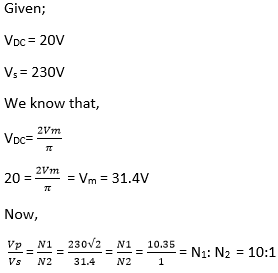
15) In the given 8085 microprocessor, the restart instruction(RST) is 8 instruction. What would be the transfer program execution to a given location?
- (0020)H
- (0030)H
- (0040)H
- (0010)H
Answer: c
Explanation:
Given;
Restarts instructions (RST)= 8
So the location = 8×8 =(64)10
= (0040)H
16) The purpose of dummy coil in D.C. machine is
- to reduce losses
- to Improve machine efficiency
- to maintain a mechanical balance of armature
- to reduce the cost of the machine
Answer: c
Explanation: The purpose of a dummy coil in a D.C. machine is to maintain a mechanical balance of armature. It is used in vacant slots of armature in D.C. machines. The dummy coils are exactly the same as other coils except that the end of the dummy coils is taped. Dummy coils are used with the machine’s wave winding, and they are used when the winding is not met the standard winding. Dummy coils do not hinder the performance of the other electrical characteristics because they are not attached to the commutator.
17) The load factor of a plant is 0.8, and the capacity factor is 0.7. If the maximum demand on the plant is 600 MW, find the reserve capacity of the plan
- 25
- 85
- 105
- 120
Answer: b
Explanation:
Given;
Maximum demand = 600MW
Load factor = 0.
Capacity factor = 0.7
To calculate the reserve capacity of the plant first, we need to calculate the Plant load factor.
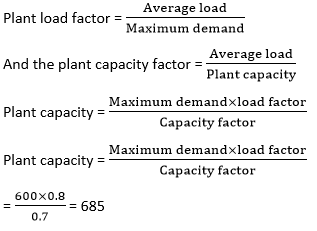
Reserve capacity of plant = Plant capacity – Maximum demand
= 685 – 600 = 85 MW
18) A bulb of power rating 9kW draws a current 30 A. Find the applied Volage
- 220 V
- 240 V
- 280 V
- 300 V
Answer: d
Explanation:
Given;
Power(P) = 9kW = 9000W
Current (I)= 30 A
We know that
Power = Product of Voltage and current
P = V × I

19) In the MKS system, the value of 3 kW is equal to
- 2.013Hp
- 3.013Hp
- 4.021Hp
- 5.021Hp
Answer: c
Explanation:
1Hp equals 746 electrical watts, which is 0.746 kW. If you reverse the math and make 1kW a reference, we will get
1hp = 0.746kW
X = 3 W
X = (3kW×1Hp)/0.746
So 3kW equals 4.021Hp
20) The resistivity of a conductor depends on
- Length
- Current
- Voltage
- Power
Answer: a
Explanation:
The resistivity of a material refers to the resistance of a wire of that material of unit length and unit cross-sectional area.
Resistance = 
ρ= A × resistance/A
Here, ρ=resistivity; l = length and A = cross-sectional area. The S.I. unit for resistivity is the ohm-meter. The resistivity of a material depends on its type and the temperature of the conductor, but not on its dimension. A good conducting material has less resistivity, whereas a bad conducting material or insulator has high resistivity. The resistivity of semiconductor material usually lies between conductor and insulator.
21) A 200 kVA transformer has a full load copper loss of 400 W and iron loss 200 W. The maximum efficiency of the transformer will occur when a total loss is
- 500 W
- 600 W
- 1500 W
- 1600 W
Answer: b
Explanation:
Given;
full load copper loss = 400 W
iron loss = 200 W
The maximum efficiency of a transformer occurs when the copper loss becomes equal to the core loss.
Here,
Total loss = full load copper loss (400 W) + iron loss (200 W) = 600 W
Therefore, maximum efficiency of the transformer total loss = 600 W
22) A 4 pole, three-phase induction motor is supplied by 50Hz frequency by a three-phase source. If the rotor of the motor rotates at 600 rpm, find the sli
- 0.2
- 0.4
- 0.6
- 0.8
Answer: c
Explanation:
Given;
No of poles (P) = 8
Frequency (f) = 50Hz
Rotor speed (Nr) = 600 rpm
In the three-phase induction motor, the speed of the synchronous motor is given by
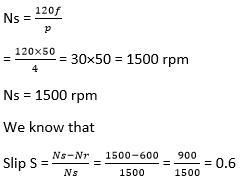
23) TRIAC is operated at
- Low Frequencies
- Power Frequencies
- High frequencies
- All of these
Answer: b
Explanation: TRIAC stands for Triode for alternating current. It is a semiconductor device that is mostly used for power frequency operation. It is the basic form of Transistor for A.C. It works as a transistor and controls the flow of current between Emitter and Collector by regulating current on Base. It has three terminals Gate and two Anodes. It is used to control the speed of various rotating devices like fans by controlling gate current with a circuit using Diac.
24) Five thyristors each of 2000 V rating are connected in series with a power circuit of 5 V.K. Find the percentage series derating factor?
- 40
- 50
- 60
- 70
Answer: b
Explanation:
Given;
Total voltage = 5 KV = 5 ×103 V
Number of thyristors(n) = 5
Rating of each thyristor = 2000 V
So, the percentage efficiency is given by

25) In an intrinsic semiconductor, the number of holes is ……. the number of electrons.
- Equal to
- More than
- Less than
- None of these
Answer: a
Explanation: The number of holes is equal to the number of electrons in an intrinsic semiconductor. Intrinsic semiconductor refers to a semiconductor whose electrical conductivity lies between conductor and insulator. The semiconductors are divided into two categories based on impurity, the first is an intrinsic semiconductor, and another is an extrinsic semiconductor. Intrinsic semiconductors are undoped semiconductors ( Zero impurities), so the number of free electrons is calculated by the material properties itself instead of impurities. Silicon (Si) and Germanium (Ge)are the best examples of intrinsic semiconductors. It belongs to the fourth group of the periodic table. The atomic number of Silicon is 14, whereas Germanium is 32 and has four electrons in its valence shell.
26) Find the value of emitter current of a transistor that has ADC = 0.5 and base current = 120 µA
- 0.01 mA
- 1.24 mA
- 0.04 mA
- 0.24mA
Answer: d
Explanation:
Given;
Base current IB =120 µA
ADC (α) = 0.5
IE = ?
We know that,
IE= Ic+ IB
Where,
IE = Emitter current
IB= Base current
IC = Collector current
Therefore,
IE= β IB+ IB= (β + 1) IB
And,

IE = (β + 1) IB
= (1+1) × 120 µA
= 2 × 120 µA = 240 µA = 240×10-3 = 0.24mA
27) Which of the given material is used for making light-emitting diodes?
- Si
- Ge
- GaAs
- Fe
Answer: c
Explanation:
GaAs (Gallium Arsenide) is used for making light-emitting diodes (LEDs). In GaAs, the number of photons(Packet of energy) is enough to create a visual light source. In semiconductors, Si comes first, but unfortunately, it is not used to make LEDs.
GaAs is a direct bandgap semiconductor with minimum conduction bandgap. The maximum valence band lies on a perpendicular straight line so the recombination can occur; thus, the conserving momentum can emit visible light.
28) Noise is a function of which of the given term
- Momentum
- Acceleration
- Voltage
- Bandwidth
Answer: d
Explanation: Noise is a function of bandwidth. Bandwidth refers to the amount of data that can be delivered from one point to another in a given time. Its bandwidth unit is bits per second, like 50 Mb/s, which means the rate of data transfer is 50 million bits per second.
29) The displacement measuring Instrument LVDT works on the principle of
- Fleming Left-hand rule
- Mutual Induction
- Linear induction
- Linear capacitance
Answer: b
Explanation: LVDT stands for Linear Variable Differential Transformer. It is an instrument that works on the principle of mutual induction. It is an instrument that measures the mechanical distance between two points.
30) Which of the gien material does not change the resistance with varying temperature
- Gallium
- Manganin
- Tungsten
- Copper
Answer: b
Explanation: The material Magnin does not change the resistance with varying temperature because Magnin has zero temperature coefficient, and the length of the alloy material does not change with temperature.
31) In a power plant, the maximum demand is 100MW, and the sum of individual maximum demand is 70 M.W. Calculate the diversity factor
- 0.5
- 0.6
- 0.7
- 0.8
Answer: c
Explanation: Diversity factor refers to a ratio of the sum of individual maximum demand to the power plant maximum demand.

Given;
Individual maximum demand = 70 MW
Power plant maximum demand = 100 MW

32) Which of the following is a series type unbalanced fault that occurs in a power system
- Single line to double line fault
- Double line to double line fault
- The line to line fault
- Open conductor fault
Answer: d
Explanation:
: In a three-phase power system, electrical faults are divided into two categories, open circuit, and short circuit faults
Open circuit faults: Open circuit faults occurs mainly due to conductor failure. The primary cause of these faults incorporates failures of overhead lines and melting of a fuse in one or more phases. It is also called series faults
33) The three-phase oil circuit breaker rated as 2000 MVA, 66 K.V., 6 SEC. Find the making current
- 13.44 kA
- 19.43 kA
- 22.76 kA
- 27.55 kA
Answer: b
Explanation: Making current of a circuit breaker refers to a peak value of the maximum current loop during sub transient condition.
Given;
Symmetrical breaking capacity = 2000 MVA
VL = 66 Kv
Therefore,

So, the making current = 2.55 × symmetrical breaking current
= 2.55 × IB
= 2.55 × 7.62 kA
= 19.43 kA
34) In a three-phase induction motor, the rotor power output is 20 kW, and the value of the corresponding slip is 8 %. Find the rotor copper loss of the motor
- 1288 W
- 1596 W
- 2033 W
- 2522 W
Answer: b
Explanation:
Given:
Rotor power output (Pm) = 20 k
Slip (S) = 8 % = 0.08
So,
Rotor power output (Pm)= Pg (1-S)

Therefore,
Rotor copper loss = sPg = 0.08 × 19.92 = 1.596 kW = 1596 W
35) Which of the given relays can resist the possible major fault in the transformer
- Current relay
- Frequency relay
- Buchholz relay
- Overcurrent relay
Answer: c
Explanation: Buchholz relay can resist the possible major fault in the transformer. It is a device that senses the total heat developed inside the transformer due to faults and sends pulses to trigger an alarm to alert. It has a part named a floater that senses the oil level in the conservator. When excessive heat is developed inside the transformer, it evaporates the oil, which turns into gas, proceeds to rise upwards because of convection. Thus it leads to a decrease in the level of oil in the conservator of the transformer.
36) In a three-phase transformer, the primary winding is delta connected, and the secondary winding is star connected, and the secondary to primary turn ratio per phase is 15. If 240 V is applied to the transformer’s primary side, find the secondary voltage of the transformer.
- 5532 V
- 6625 V
- 6235 V
- 7325 V
Answer: c
Explanation:
Given;
∆/γ connection
Secondary to primary turn ratio = 15
V1 = 240 V
So,
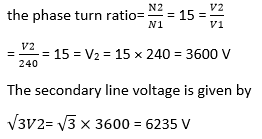
37) Which of the given diode is called hot-carrier dioxide?
- P.N. junction diode
- Schottky diode
- Light-emitting diode
- Zener diode
Answer: b
Explanation:
Schottky diode is called a hot-carrier diode.
It is formed when metal and semiconductor are interfaced. It has a low forward voltage drop and fast switching response, so they are used in high-power applications such as high-power rectifiers. They are preferred for high frequency like a radiofrequency application over the normal p-n junction diode.
38) In a transformer, the humming sound is primarily due to
- Overflow of oil
- Magnetostriction
- Flux leakage
- Lamination of transformer
Answer: b
Explanation: The primary reason for transformer noise is Magnetostriction. In the transformer, the expansion and contraction of the iron core laminations due to the magnetic effect of alternation current flowing through the transformer coils. It generates a humming noise. Magnetostriction may be partially controlled by the transformer’s design, but it cannot be totally eliminated. However, it can be reduced through proper design and assembly and masked through proper consideration of the installation.
39) When a 20 A current flows for 6 minutes, calculate the amount of electricity transferred.
- 7200 C
- 6400 C
- 8400 C
- 5400 C
Answer: a
Explanation:
Given;
I = 20 A
t= 6 minutes
we know that

40) Find the barrier potential for Si junction diode at 100 C, calculate its value at 400 C is 0.9 V
- 0.75 V
- 0.96 V
- 1.20 V
- 0.60
Answer: b
Explanation:
Given;
T1 = 100 C
T2 = 400 C
We know that,
∆V= -0.002(T2– T1)
= -0.002(10- 40) = 0.06 V
So the barrier potential at 100 C is
VB= 0.9 + 0.06 = 0.96 V
41) An induction machine is operated with frequencies that are given in the ratio 3:7 without changing the voltage. Find the starting torque of the machine for the given frequencies
- 2:7
- 3:7
- 4:7
- 5:7
Answer: b
Explanation:
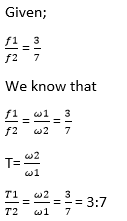
42) The voltage range is non uniform. Its type is
- Electrostatic instrument
- Potentiometer
- Galvanometer
- Multimeter
Answer: a
Explanation:
In an electrostatic instrument, the voltage range is uniform.
We know that

For MI,
Q is directly proposal to the square of the current.
43) Which of the given test is used for the calculation of the inertia of the rotor?
- Sinners test(Back to Backtest)
- Low voltage test
- High Voltage test
- Retardation test
Answer: d
Explanation: The retardation test is used for the calculation of the inertia of the rotor. The moment of inertia plays a vital role in selecting a motor for drives involving speed control characteristics. The basic principle on which the retardation test work is that when a motor is switched off from the power supply, it decelerates and come to rest. The retardation (Varying speed) is directly proportional to the retarding torque and inversely proportional to the inertia.
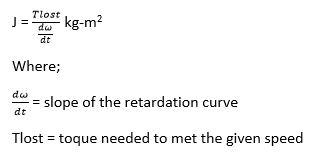
44) In a series resonance circuit, what is the value of the Impedance at half power frequencies

Answer: c
Explanation:
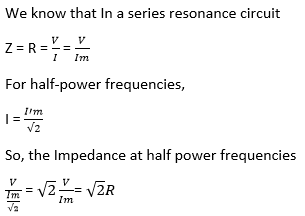
45) A galvanometer having the value of coil resistance is 120 Ω gives a full-scale deflection when a current of 3mA is passed through it. Find the value of the resistance, which can convert a galvanometer into an ammeter, giving a full-scale deflection for a current of 12 A.
- 0.07 Ω
- 0.09 Ω
- 0.11 Ω
- 0.03 Ω
Answer: d
Explanation:
Given;
Rg = 120 Ω
Ig = 3 mA
I = 12 A
Rs ?
If the galvanometer’s resistance is considered as Rg, it gives a full-scale deflection when the current Ig is passed through it.
So,
V = RgIg
V = 3mA × 120Ω
Now, consider a shunt resistor Rs, which is connected in parallel to a galvanometer. When we consider a total current passing through the circuit is I
Then,
I = Is + Ig and
V = IsRs = (I-Ig)Rs because (Is = I-Ig) from the above equation
(I-Ig)Rs = IgRg
(12 – 3 × 10-3)Rs = 120 × 10-3
(11.997)Rs = 0.36

46) Find the numbers of address lines needed to address a memory size 64K
- 10
- 12
- 14
- 16
Answer: d
Explanation:
Memory size = 64K, it means
= 64 × 1024 bytes = 26× 210 =216 bytes
Therefore,
The number of address lines needed to address a memory size 64K = 16
47) A 3 phase Induction motor having 70 Hz frequency draws a power of 80 kW from mains. If the stator losses are 4kW and rotor emf oscillates at 120 oscillations per minute, find the rotor copper losses
- 0.26 kW
- 0.54 kW
- 0.10 kW
- 0.99 kW
Answer: b
Explanation:
Given;
fs = 70Hz
fr = 120/60 = ½
Stator loss = 4kW
Rotor Copper loss ?
We know that,

Rotor input = Stator input – stator loss
= 80 – 4 = 76kW
Rotor copper loss = S × Rotor input

48) In an induction motor, crawling is caused by
- High Voltage
- Heavy loads
- Harmonic produced in the motor
- Improper design of machine
Answer: c
Explanation: The term crawling is associated with the squirrel cage induction motor. The squirrel cage induction motor has a tendency to run at a slow speed as compared to its synchronous speed; this phenomenon is called crawling. The squirrel cage induction motor.
49) In a ferromagnetic material, the neighboring atomic magnetic moments are
- Predominantly unequal in small regions of material.
- Predominantly constant in small regions of material.
- Predominantly unequal and parallel throughout the material.
- Predominantly equal and parallel throughout the material.
Answer: d
Explanation: Ferromagnetic materials refer to those substances which show permanent dipole moment even in the absence of an externally applied magnetic field. They have their magnetic moments arranged parallel to the direction of the applied magnetic field by the orientation of the individual domains within the material towards the applied magnetic field.
50) N-type and P-type extrinsic semiconductors are formed by adding the impurities of which valency.
- Tertavalent and pentavalent
- Trivalent and pentavalent
- Pentavalent and trivalent
- Trivalent and tetravalent.
Answer: b
Explanation: Pentavalent impurity refers to an impurity that consists of 5 valance electrons and is shared with neighboring Si atoms, and the rest of the electrons is free to move that are responsible for conduction. It produces an electron as a majority charge carrier. Trivalent impurity refers to an impurity that consists of 3 valance electrons and is shared with neighboring Si atoms to produce a p types semiconductor by producing a hole as a majority charge carrier.
51) An 8 pole, 1600 rpm D.C. lap wound generator has 1680 conductors. If the flux per pole is 0.04 weber, find the emf of the generator.
- 1600 V
- 1792 V
- 1982 V
- 2020 V
Answer: c
Explanation:
Given;
P = 8
N = 1600 rpm
Z = 1680
Ø = 0.04 Weber
In lap wound generator
A=P=8
E ?
We know that the emf generated.

52) The input voltage of a boost regulator is 8V, and the average output voltage is 24V. Find the duty cycle.

Answer: b
Explanation:
Given;
Vo = 24 V
Vs = 8
α =?
We know that,
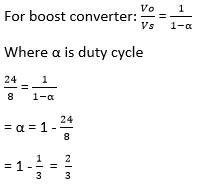
53) In which of the given single-phase motor, the rotor has no teeth or winding?
- Shaded pole motor
- Capacitor start motor
- A permanent capacitor run the motor
- Hysteresis motor
Answer: d
Explanation: Hysteresis motor refers to a synchronous motor with a uniform air gap and starts without D.C. excitation. In this motor, the rotor has no teeth or windings.
54) 1 volt can be expressed as
- 1 joule/weber
- 1 joule/ columb
- 1 joule/ohm
- 1 watt/ Joule
Answer: b
Explanation: Voltage can be express as work done per unit charge.

Unit of voltage = Joule/ coulomb
55) A single-phase having a rating of 11 kVA, 4400/440 V, 50 Hz, distribution transformer is to be connected as an auto-transformer to get an output voltage of 3260 V. Find its maximum kVA rating as an autotransformer.
- 111
- 121
- 144
- 169
Answer: b
Explanation:
We know that voltage rating is additive that is 4400+440 = 4880 V
Let a2wdg be the secondary winding of the autotransformer

(KVA)auto= (a2wdg + 1) × (KVA) 2wdg = (10+1) × 11 = 11 × 11 = 121 KVA
56) The starting current of a three phase induction motor is 3 times the rated current, while the rated slip is 8 %. Find the ratio of starting toque to full load toque
- 0.5
- 0.75
- 0.72
- 0.80
Answer: c
Explanation:
Given;
Ist = 3 If
Sfl = 8 % = 0.08
We know that,
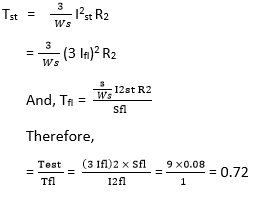
57) The Ybus matrix of a 200 bus interlinked system is 70 % sparse. Find the number of transmission lines in the system
- 8100
- 7200
- 5900
- 4700
Answer: c
Explanation:
Given;
Number of buses, N = 200
Sparsity, s = 0.7
We know that, the equation to calculate transmission line
NT = N2(1-s) – N / 2
= (200)2(1-0.7)-200 / 2
= 5900
58) A negative sequence really is usually used to protect
- A transformer
- An Alternator
- A transistor
- A Junction
Answer: b
Explanation: A negative sequence is referred to a realy that is used to protect an alternator. It refers to a relay that protects the electrical machine from the negative sequence component.
59) A potentiometer is usually a
- Digital Instrument
- Deflection type instrument
- Null type instrument
- None of these
Answer: c
Explanation: A potentiometer is usually a null-type instrument. It is an electronic instrument used to find the EMF.
60) An amplifier has a gain of 30 without feedback. If 20 % of the output voltage is a feedback using its resistance negative feedback circuit, find the overall gain?
- 3.67
- 4.28
- 9.85
- 7.47
Answer: b
Explanation:
Given;
A = 30
And β = 20 % = 0.2
Because feedback is negative

